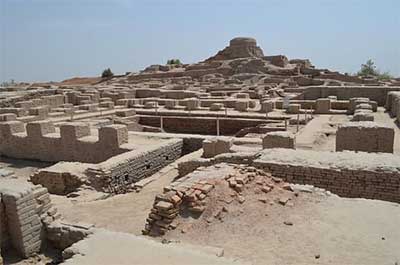Indus Valley Civilization
CONTEXT:
The Indus Research Centre launched a website "Indusscript.in" for studying and analysing the Indus scripts. This has been with the help of financial grant by Department of Archaeology. This provides an alternative for the book "The Indus Script: Texts, Concordance and Tables" written by Iravatham Mahadevan, that wasn't available everywhere for study.
FOR PRELIMS:
- Indus civilization, also called Indus valley civilization or Harappan civilization, the earliest known urban culture of the Indian subcontinent.
- The nuclear dates of the civilization appear to be about 2500–1700 BCE, though the southern sites may have lasted later into the 2nd millennium BCE
- The civilization was first identified in 1921 at Harappa in the Punjab region and then in 1922 at Mohenjo-daro (Mohenjodaro), near the Indus River in the Sindh (Sind) region. Both sites are in present-day Pakistan, in Punjab and Sindh provinces, respectively. The ruins of Mohenjo-daro were designated a UNESCO World Heritage site in 1980.
- Geographically, this civilization covered Punjab, Sindh, Baluchistan, Rajasthan, Gujarat and Western Uttar Pradesh. It extended from Sutkagendor (in Baluchistan) in the West to Alamgirpur (Western UP) in the East; and from Mandu (Jammu) in the North to Daimabad (Ahmednagar, Maharashtra) in the South. Some Indus Valley sites have also been found as far away as Afghanistan and Turkmenistan.
Structural Organisation
- The Indus civilization is known to have consisted of two large cities, Harappa and Mohenjo-daro, and more than 100 towns and villages, often of relatively small size. The two cities were each perhaps originally about 1 mile (1.6 km) square in overall dimensions, and their outstanding magnitude suggests political centralization, either in two large states or in a single great empire with alternative capitals.
- Most cities had similar patterns. There were two parts: a citadel and the lower town. Most cities had a Great Bath.
- There were also granaries, 2-storied houses made of burnt bricks, closed drainage lines, excellent stormwater, and wastewater management system, weights for measurements, toys, pots, etc.
Trade
- The civilization subsisted primarily by farming, supplemented by an appreciable but often elusive commerce.
- Wheat and six-row barley were grown; field peas, mustard, sesame, and a few date stones have also been found, as well as some of the earliest known traces of cotton.
- Domesticated animals included dogs and cats, humped and shorthorn cattle, domestic fowl, and possibly pigs, camels, and buffalo. The Asian elephant probably was also domesticated, and its ivory tusks were freely used.
- Trade was extensive and apparently well-regulated, providing imported raw materials for use at internal production centres and distributing finished goods throughout the region.
Craft and Artifacts
- The apparent craft specialization and localized craft groupings at Mohenjo-daro, along with the great divergence in house types and size, point toward some degree of social stratification.
- The popular art of the Harappans was in the form of terra-cotta figurines. The majority are of standing females, often heavily laden with jewelry, but standing males—some with beard and horns—are also present.
- The best-known artifacts of the Indus civilization are a number of small seals. The seals were generally cut from steatite (soapstone) and were carved in intaglio or incised with a copper burin (cutting tool). The great majority of seals show a humpless “unicorn” or bull in profile, while others show the Indian humped bull, elephant, bison, rhinoceros, or tiger.
- Civilization also was advanced in making artworks. A statuette named ‘Dancing Girl’ has been found from Mohenjodaro and is believed to be 4000 years old. A figure of a bearded Priest-King has also been found from Mohenjodaro.
- Metals found copper, bronze, gold, silver and lead. Other special crafts include the manufacture of faience (earthenware decorated with coloured glazes)—for making beads, amulets, sealings, and small vessels. Several varieties of etched carnelian and long barrel beads were made with extraordinary skill and accuracy. Shell and ivory were also worked and were used for beads, inlays, combs, bracelets, etc.
Worship
- No structures like temples or palaces have been found. The people worshipped male and female deities. A seal which was named ‘Pashupati Seal’ has been excavated and it shows an image of a three-eyed figure. Marshall believed this to be an early form of Lord Shiva. They also worshipped 'linga'.
The remarkable uniformity of weights and measures throughout the Indus lands, as well as the development of such presumably civic works as the great granaries, implies a strong degree of political and administrative control over a wide area.
Disposal of the dead was by burial in wooden coffins. Later on, in the H Symmetry culture, bodies were cremated in urns.
The Indus Valley script has not yet been deciphered.
Causes of Decline
- Causes of the decline of this civilization have not been firmly established. Archaeologists now believe that the civilization did not come to an abrupt end but gradually declined. People moved eastwards and cities were abandoned. Writing and trade declined.
- Mortimer Wheeler suggested that the Aryan invasion led to the decline of the Indus Valley. This theory has now been debunked.
- Robert Raikes suggests that tectonic movements and floods caused the decline.
- Other causes cited include a drying up of the rivers, deforestation, and destruction of the green cover. It is possible that some cities were destroyed by floods but not all. It is now accepted that several factors could have led to the decline of the Indus Valley civilization.
- New cities emerged only about 1400 years later.

Sources
- The Indian Express
- Old NCERTs class 6-8
- Britannica







